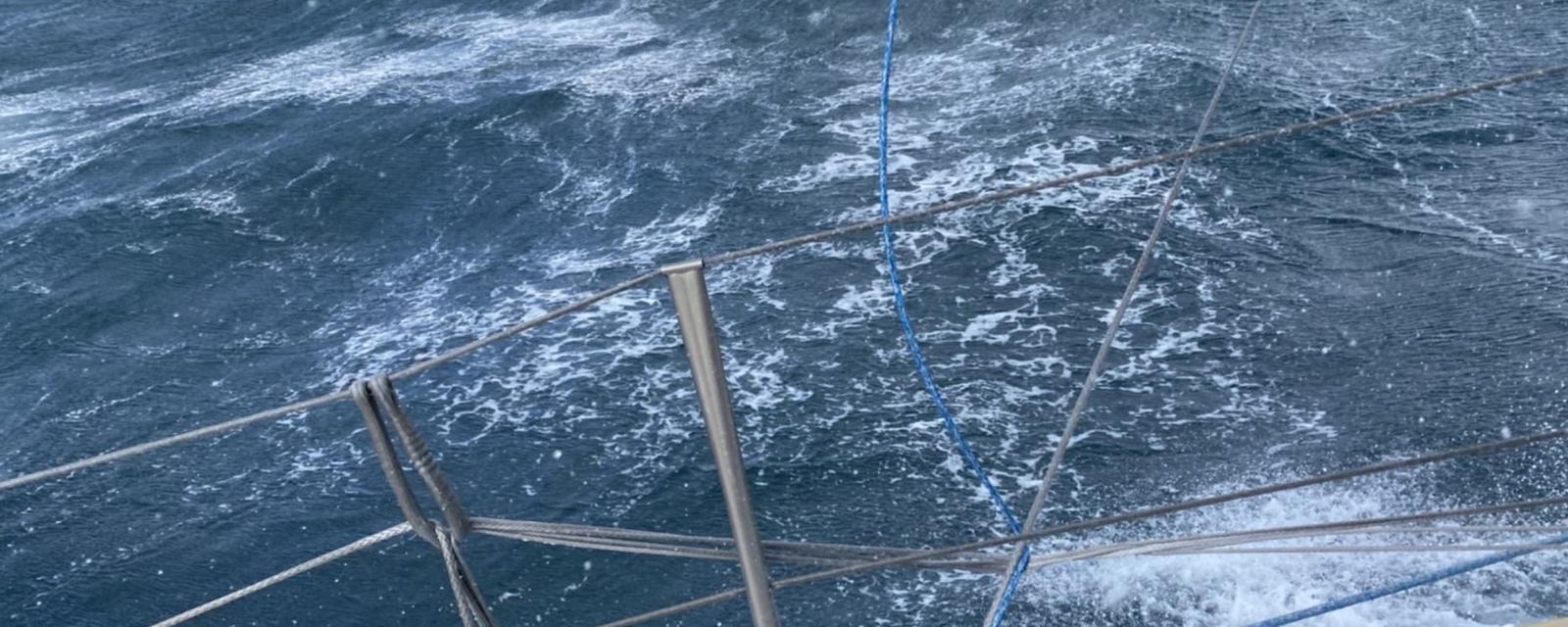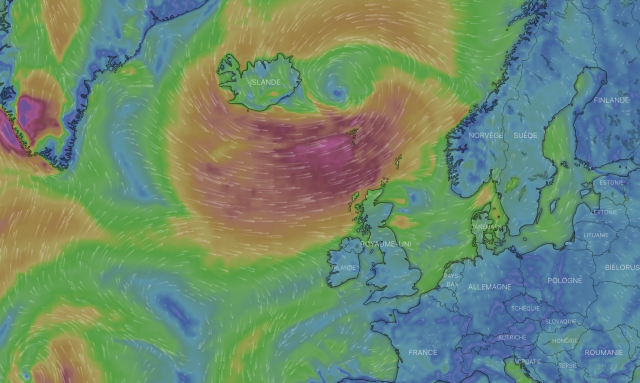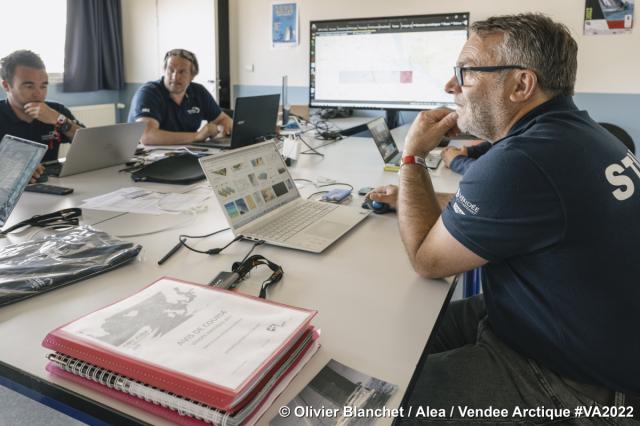"I had my eyes glued to it," confides Isabelle Joschke. “When you see a big red spot (materializing depression) which extends over the entire screen, you say to yourself that it will be difficult to manage.” The MACSF navigator was not the only one to think so. "By deepening and moving towards the northeast of Iceland, the depression would have made it very difficult for part of the fleet to progress around the island,” continues Christian Dumard. "We did a routing for all of the 24 boats still in the race,” explains Yann Château. And for the last 13, they would have had to face 40 knots, which comes to almost 50 knots in these latitudes.”

48 Hours of Tension
- Share
Last Friday, race management decided to make the Iceland Gate the finish line of this Vendée Arctique - Les Sables d’Olonne. The main reason: a depression that widened and spread over a substantial part of the course. This choice owes nothing to chance or improvisation. It follows a series of analyses and concerted decision-making to ensure the safety of skippers.
The race management had talked about the weather feature at the traditional pre-race briefing alongside all the skippers, a depression that was forming east of Newfoundland. “We knew we had to watch it,” explains Christian Dumard, the race meteorologist. The probability models then predicted that "the deepening of the depression was very weak.” But caution is in order.
"We knew that the course was ambitious and involved an element of risk,” continues Francis Le Goff, the race director. “We have always been transparent on this subject.” Sunday, June 12, the sailors set off, full of enthusiasm and promise. Quickly, the race regains its rights: an ultra-fast tack to start then the ridge which blocks the way of the fleet, the foilers which pass to the West, the others to the East.
"When you see a big red spot on the screen..."
At the same time, further north, the situation was becoming tense and conditions were deteriorating. The cursed depression continued to deepen and seemed to be gradually rising towards the east of Iceland. "There is a tendency in the northern regions for the depressions to deepen faster than on the models,” confides Yann Château, assistant to Francis Le Goff in the race management. On board the monohulls, studying the weather files, the skippers did not miss a beat.

"Guarantee the safety of the fleet"
On the night of Wednesday to Thursday, exchanges are increasing within the organization. Especially since the more the boats progressed towards the North, the more complex the situation. “Gradually, there were no longer ten of them able to escape depression, but only seven or eight,” says Francis Le Goff. Even if the race management, via Yann Château, had had contact with the Icelandic authorities before the start, it was also necessary, according to Francis, "to take into account the intervention capacities of the rescuers. The solo is a French exception, we we did not have the guarantee of being able to insure them.” The challenge is also to "guarantee the safety of the fleet,” maintains Alain Leboeuf, president of SAEM and the Department of Vendée.
In order to coordinate and streamline the exchanges between the president, the race management and the race communication teams, Laura Le Goff, general manager of SAEM Vendée, acted as a "transmission belt.” “We applied the same crisis management protocol as when there is a major problem on a boat,” she explains. “Racing always helps to facilitate the decision-making process.” A decision was needed and it was formalized Thursday at the beginning of the afternoon: the bypass of Iceland is canceled, a new route, providing for the passage to a door in the south-east of the island, is approved.
But this decision did not solve everything. The issue again with this depression was it continued to widen, to the point of blocking the direct route of the first three. “On the one hand, the rear of the fleet found itself trapped in this depression, on the other, the first three – Charlie Dalin (APIVIA), Jérémie Beyou (Charal) and Thomas Ruyant (LinkedOut) – would also have had to manage a passing head-on with very strong winds on their direct route," said Francis Le Goff. The top group would also have had to deal with a second depression on the way down which could have seen the same scenario play out again.
"Leaving would have been a second round with unequal weapons"
"At this moment, the rest of the fleet began to be in the grip of depression,” says Francis Le Goff. The issues were swirling around. There is the "security" aspect for those still in the race and to find a way to take shelter within such a restricted perimeter. And then there was the sports factor. "How were we going to restart the race without distorting the 1st stage?” Says Le Goff. “How to guarantee sporting fairness between those who would have taken shelter and those who had just come out of the depression?"
"Leaving again would have been a second round with unequal weapons because the sailors and their boats would not have been in the same state,” concludes Château. To continue the race or not after the neutralization monopolized the attention of all the stakeholders from Friday to Saturday. "At that time, there were a lot of exchanges and consultation,” underlines Laura Le Goff, in permanent contact with Alain Leboeuf, president of SAEM and the Department of Vendée. “The decision of the race management in the matter had to be as enlightened as possible before being approved.”

On the water, the conditions were not helping, once again. "Things weren't easing at all, it was a hassle for those in the race and complicated for those who had arrived to stay in their bubble of concentration,” sighs Francis Le Goff. Gradually, an idea begins to gain consensus: stop the race at this gate of Iceland. It would be recorded late Friday evening, a "wise decision for the safety of sailors,” according to Laura Le Goff.
“Restarting the race would have been complex and we had no guarantee that this 2nd leg would be a sporting performance in itself and would not turn into a delivery trip,” explains race director Le Goff. “However, we also had to highlight what the skippers had already done, this very committed, very intense regatta. By making this stop, we were also keen to highlight the battle that had taken place since the start."
The exceptional harshness of the conditions
Saturday night, when the decision was formalized, Charlie Dalin was named the winner. "I was still working on the course for a possible new start," explains Dalin. “It was special to learn that at anchor!”
The hours that followed confirmed the knockout caused by the depression, which was particularly violent when approaching the finish in heavy upwind sailing. The damage was increasing in the fleet: mainsails torn for Isabelle Joschke (MACSF) and Giancarlo Pedote (Prysmian Group), heavily damaged sail set for Conrad Colman (Imagine), serial problems for Kojiro Shiraishi (DMG MORI GLOBAL ONE), and a damaged hydrogenerator for Romain Attanasio (Fortinet-Best Western). "I thought I would never cross the finish line,” explains an exhausted Attanasio. "It was the hardest thing I've done on a boat,” Éric Bellion (Eric Bellion, COMME UN SINGLE HOMME Powered by ALTAVIA) concurred.
Manu Cousin (SETIN Group) turned back, Isabelle Joschke, Arnaud Boissières and Denis Van Weynbergh (Biarritz Laboratories) – who injured his thigh and lost a rudder – decided to retire. "That says a lot about the exceptional harshness of the conditions,” says Château. “There have been very few offshore races where three boats retired less than 50 miles from the finish.”
"I have never faced such harsh conditions," explains Fabrice Amedeo, who saw 62 knots on hs anemometer. The sailors spoke of "dangerous conditions" (Alan Roura, Hublot), of "particularly intense rhythm,” of their boat that “leaned at 90°" (Eric Bellion, COMME UN SEUL HOMME Powered by ALTAVIA).
Crossing the line has the value of deliverance. On their boats tossed about by the elements, the Icelandic coast offered itself as a reward. Above all, they could finally breathe. The pressure falls and everyone realizes what they survived. It's time for tears, too. "I cried like a kid," says Arnaud Boissières. "I'm so tired that I'm becoming a little more emotionally fragile," admits Giancarlo Pedote. Like a cry from the heart, Amedeo sums up the thoughts of the entire fleet: "We're tired of it…to come here!" For now it is time to rest, recuperate and return to Les Sables d'Olonne. Guirec Soudée (Freelance.com), who knows a lot about the subject, is sure of his experience: "This race was a great adventure.” And these modern-day adventurers have just added a new piece of bravery to their memories.



